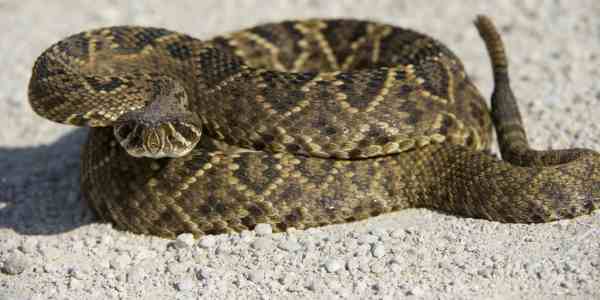It’s no secret that Aruba has much to offer tourists. From the beautiful beaches and turquoise waters to the diverse array of sights and experiences, the Caribbean island attracts millions of people each year. And while the wildlife on Aruba is undoubtedly stunning, it can be easy to forget that some of these creatures can pose a threat to humans.
Table of Contents
In 2019 alone, nearly two million guests visited Aruba and with more people flocking to this Caribbean oasis every day, it’s important to explore both the animal kingdom and its potential dangers before your visit. We want all vacationers in Aruba to enjoy an incredible experience without any unwelcome surprises.
Here are six of the most hazardous animals that live in Aruba.
1. Venomous Pit Vipers/Aruba Rattlesnakes
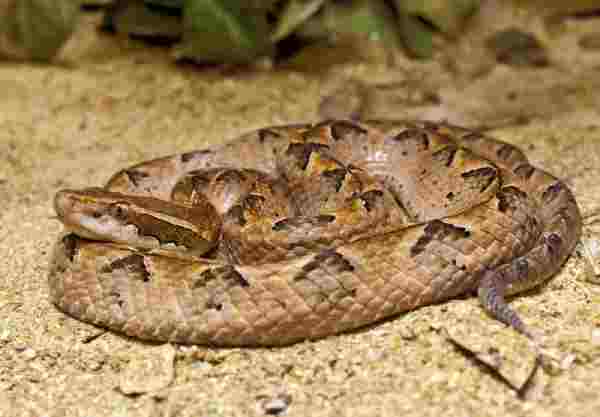
Scientific name: Crotalus unicolor
Classification: Reptile
Habitat: Dry and rocky terrains
Diet: Carnivore
Conservation status: Critically Endangered
Brief summary: Because these snakes avoid humans, their severe, venomous bites can result in devastating health problems.
Found exclusively on the Caribbean island of Aruba, Venomous Pit Vipers are critically endangered with just 230 species left in the world. These snakes, also known as Aruba Rattlesnakes, take comfort in the dry and rocky terrains of the low-eastern side of the island.
Their diet usually consists of Aruba Whiptail lizards and birds, giving them some variation in their meals. Plus, travelling isn’t something that these Aruban rattlers like to do as they tend to remain within a small area ranging between 1-2 square miles throughout most of their lives!
Although you may be lucky enough to catch sight of one while visiting the island, these creatures tend to shy away from people so you don’t have to worry about running into a potential hazard.
What Makes Aruba Rattlesnakes Dangerous?
- These rattlesnakes have been known to bite people over the years, despite their rarity.
- Aruba rattlesnake bites are certain to be severe due to their venomous teeth. Don’t worry; a small percentage of these snakes’ bites will be “dry,” which means they won’t inject venom.
- Snakes have the capacity to discharge a sizable amount of venom when they bite. The tissue of human skin can be destroyed by their venom.
- Additional possible side effects from an Aruba rattlesnake bite include internal haemorrhage, shock, seizures, compartment syndrome, and possibly organ failure.
2. Sharks
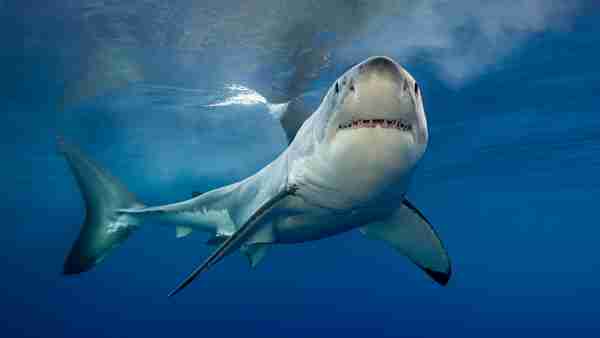
Scientific name: Selachimorpha
Classification: Chondrichthyes
Habitat: Deep oceanic areas
Diet: Carnivore
Conservation status: Endangered
When planning a trip to Aruba, the glorious beaches may be at the forefront of your mind. However, while enjoyed by people near and far, these shorelines are also home to many different species of sharks. Among those frequently seen in this area are the Caribbean Reef Shark, Nurse Shark, Tiger Shark and Blacktip Reef Shark.
Visitors should note that the size and colour of sharks in the waters around Aruba can range drastically: some have lengths as small as four feet while others can weigh as much as thirty-two feet!
The only small consolation here is that it’s unlikely you’ll cross paths with one of these majestic creatures simply because they often inhabit depths away from where swimmers lay claim.
Therefore tourists should take caution when visiting Aruba for various aquatic activities, such as snorkelling, boating, and scuba diving. The deep seas of the island mostly contain non-aggressive sharks, but accidents can still occur if one doesn’t keep a safe distance.
There have been no reported shark attacks since 2015, but it’s important to remain vigilant while exploring the barriers coral and amazing tropical fish of the Caribbean ocean around Aruba.
What Makes Sharks Dangerous?
- Although several of the shark species in Aruba can get fairly huge, if provoked, they will attack people swiftly.
- Humans can suffer terrible injuries from a shark’s teeth, including limb loss or even death.
- There are three forms of shark attacks: (1) “hit-and-run,” which occur the most; (2) “bump-and-bite”; (3) “sneak attacks.”
3. Jellyfish
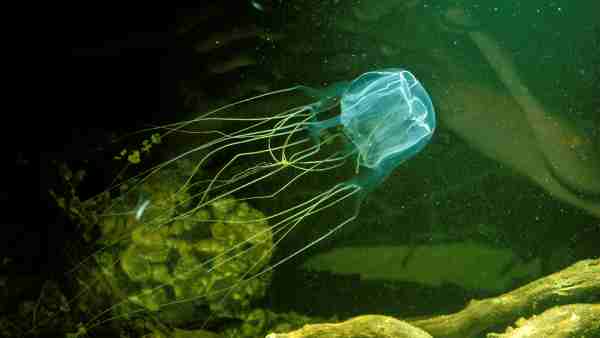
Scientific name: Aurelia
Classification: Scyphozoa
Habitat: Warm or cold oceans
Diet: Carnivore
Conservation status: N/A
Brief summary: The stings of jellyfish can be difficult to avoid, and they are frequently present in the waters around Aruba.
Jellyfish are a fascinating yet potentially dangerous species found in Aruba’s seas, and if one is not careful they may find themselves face to face with one. Although jellyfish inhabit oceanic waters, heavy rainfall can cause them to drift near the shore where swimmers are plentiful; this is due to wind sways that direct the marine currents bringing them closer to land.
Unfortunately, their transparent features make it difficult for humans to spot them early on. As a result, a swimmer could easily stumble upon an unwelcome surprise that carries the possibility of deadly repercussions. Even if one does see a jellyfish, it may not be enough time to get out of harm’s way due to their non-avoidance behaviour when it comes to humans.
What Makes Jellyfish Dangerous?
- Humans are stung by the tentacles of jellyfish. These stings are produced by a number of tiny needles that contain poison.
- Certain jellyfish species, like the box jellyfish, have the ability to kill people within minutes after stinging.
- Most jellyfish stings cause skin that is uncomfortable or burning. Usually, the human skill will turn red following a jellyfish sting.
- In addition to chest pain and difficulties breathing, more serious health effects of jellyfish stings include nausea and vomiting, abdominal pain, hyperhidrosis, and chest pain.
4. Boa Constrictors
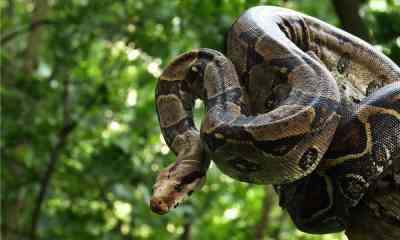
Scientific name: Boa constrictor
Classification: Reptile
Habitat: Deserts, savannas, forests
Diet: Carnivore
Conservation status: Least Concern
Brief summary: These invasive snakes can quickly suffocate their unfortunate prey due to their hooked teeth and flexible jaws.
Aruba’s warm, humid environment is almost perfect for the thriving population of boa constrictors that can be found across the island. Allowing these invasive snakes to feel right at home in Aruba, they have made themselves quite comfortable in both developed and more remote parts of the island.
With female boa constrictors capable of giving birth to up to fifty offspring at one time, their numbers grow quickly and unchecked due to their scarcity of predators. The hardy nature of these serpents allows them unprecedented opportunities for getting around Aruba with some documented hitchhiking as far as underneath cars for a quick trip.
Boa constrictors have fascinating hunting strategies and impressive size, yet they rarely attack humans. Rather than actively hunting for food, these serpents share the unique trait of being ambush predators, which means they wait for prey to approach them.
While they may petrify the average person, their most common sources of food are surprisingly small – lizards and birds. Even though boa constrictors can exceed nine feet in length when female, attacks on humans are quite rare.
What Makes Boa Constrictors Dangerous?
- Boa constrictors are enormous snakes! These snakes have been reported to weigh more than a hundred pounds and to be four meters long.
- Boa constrictors’ jaws may open extremely wide, allowing them to consume their food in one mouthful.
- The hooked fangs of these snakes allow them to grasp onto and grip their prey. Boas will then suffocate their prey while in their deadly grip.
5. Green Iguana

Scientific name: Iguana iguana
Classification: Reptiles
Habitat: Tropical climates and rainforests
Diet: Herbivores
Conservation status: N/A
Brief summary: Green iguanas are common on Aruba and are usually harmless, although if disturbed, they can attack humans.
Living on Caribbean islands such as Aruba, Bonaire and Grenada, green iguanas are a stunning sight to behold. Featuring bright greens and blacks – with the darker colour appearing if the iguana feels threatened – these lizards are also remarkable for their size, with adult males reaching two meters in length!
Aside from this impressive stature, green iguanas are proficient athletes; they climb trees and swim using their powerful tails.
Of course, one of their best defences against predators is camouflage, helping them to remain hidden during the day. When it comes to food choices, green iguanas typically enjoy leaves, fruits and flowers.
Despite this seemingly peaceful eating plan, these iguanas still have various tactics to ensure their survival on the islands in the Caribbean Sea.
When startled or threatened, the iguana reacts quickly, typically fleeing or swimming away from the predator. However, if unable to escape, it will become aggressive and use its environment for protection — particularly its teeth, claws, and spikey tail — as a shield to defend itself from larger predators.
While humans in Aruba rarely need to worry about being attacked by this species unprovoked, if provoked enough the iguana has been known to inflict serious wounds on those who threaten it.
What Makes Green Iguanas Dangerous?
- The bite of a green iguana releases venom. Despite this venom is normally safe for humans, these iguanas have powerful jaws and sharp teeth that can be painful.
- Green iguanas have spiky tails that they employ to defend themselves if they are threatened.
- Also, if necessary, iguanas can run quite swiftly toward humans.
6. Baker’s Cat-Eyed Snake

Scientific name: Leptodeira bakeri
Classification: Reptiles
Habitat: Grasslands, rainforests
Diet: Carnivore
Conservation status: N/A
Brief summary: A nocturnal reptile known as santanero lives on the Caribbean island of Aruba.
Baker’s cat-eyed snake, with its distinctive cat-like eyes and bad smell, is an animal definitely one wants to admire from a distance. Not lethal but still capable of causing great discomfort in humans, the snake should best be left alone.
Found primarily during the wet season near dams and roadsides, this species hides in tree foliage or rocks during the day before coming out during nightfall. So if you ever hear mysterious hissing or see unusual caterpillar-like slithering shadows when out for a stroll at night, it may not just be your imagination – there might be a baker’s cat-eyed snake nearby!
What Makes The Baker’s Cat-Eyed Snake Dangerous?
- The nonvenomous Baker’s Cat-Eyed Snake (Leptodeira bakeri) is native to Central and South America.
- It generates venom that is not harmful.
- Because they are not aggressive and rarely bite, their primary defence technique is concealment to escape predators or territorial disputes.
- They can still bite if threatened and should be treated with caution if discovered in the wild. It’s better to admire this snake from a safe distance, as they can become agitated if approached too closely. s
Final Words
Aruba is home to a diverse array of wildlife, from the endangered Aruban Burrowing Owl to the frisky burros of Arikok National Park. Every year, these unique animals attract droves of curious tourists who want to spot them in their natural habitats. Although most are harmless, it is important to remember that no animal can be completely trusted and you should always keep a safe distance. Staying alert and staying back is the best way to ensure that your wildlife viewing experience gets all the joy without any of the risks.
Reference:
https://www.aruba.com/us/our-island/island-facts/wildlife

Rahul M Suresh
Visiting the Zoo can be an exciting and educational experience for all involved. As a guide, I have the privilege of helping students and visitors alike to appreciate these animals in their natural habitat as well as introducing them to the various aspects of zoo life. I provide detailed information about the individual animals and their habitats, giving visitors an opportunity to understand each one more fully and appreciate them in a more intimate way.

